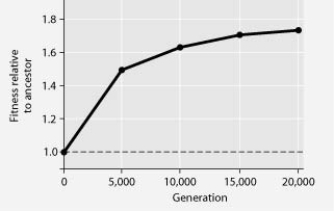The following question refers to the figure.
In this eight-year experiment, 12 populations of E. coli, each begun from a single cell, were grown in low-glucose conditions for 20,000 generations. Each culture was introduced to fresh growth medium every 24 hours. Occasionally, samples were removed from the populations, and their fitness in low-glucose conditions was tested against that of members sampled from the ancestral (common ancestor) E. coli population.
If the vertical axis of the figure above refers to relative fitness, then which of the following is the most valid and accurate measure of fitness?
Definitions:
Traditional Class
A method of instruction that takes place in a physical classroom setting, often characterized by face-to-face interactions between students and teachers.
Conflicting Views
Situations where there are opposing opinions, ideas, or interests between parties or within a topic.
Classroom Discussion
An educational technique involving an interactive exchange of ideas among students and teachers within a classroom setting.
Quantitative Courses
Academic or training programs focused on subjects that involve numerical data, statistical analysis, and mathematical computations.
Q1: Which of the following describes the most
Q16: Which of the following would, if it
Q23: The last common ancestor of all animals
Q26: Consider the following data: (a)Most ancient eukaryotes
Q30: Use the following information to answer the
Q47: In a hypothetical environment, fishes called pike-cichlids
Q65: In a hypothetical situation, the genes for
Q66: One of the characteristics unique to animals
Q67: The following question refers to the generalized
Q79: Which of the following is a characteristic